The AMD Radeon R9 Nano Review: The Power of Size
by Ryan Smith on September 10, 2015 8:00 AM ESTOverclocking
Finally, no review of a high-end video card would be complete without a look at overclocking performance.
Of all of the Fiji cards overclocking the R9 Nano is perhaps the easiest and certainly the most unusual. Due to the fact that the card is essentially a 1000MHz Fiji card with a heavy power throttle, the card is already validated for clockspeeds that under load it doesn’t have the available power to reach. As a result while one can crank up the clockspeeds, the card isn’t going to move until you increase the power limit. And even then you are more likely to hit the power cap again than you are to break 1000MHz sustained. So overclocking the GPU is something of an academic affair.
| Radeon R9 Fury/Nano Series Overclocking | |||||
| Ref. R9 Fury X | ASUS R9 Fury | Ref. R9 Nano | |||
| Boost Clock | 1125MHz | 1075MHz | 1075MHz | ||
| Memory Clock | 1Gbps (500MHz DDR) | 1.1Gbps (550MHz DDR) | 1.1Gbps (550MHz DDR) | ||
| Power Limit | 100% | 115% | 135% | ||
| Max Voltage | 1.212v | 1.169v | 1.2v | ||
Overall we were able to overclock our sample to 1075MHz on the GPU and 550MHz (1.1Gbps) on the memory. However load clockspeeds were almost always under 1000MHz even with a generous 35% increase in the power target. Overdrive does allow for a larger increase – up to 50% – but with the R9 Nano featuring a less robust power delivery system designed to push less power than R9 Fury or R9 Fury X, we’re hesitant to increase the limit further without a better idea of what the card can safely sustain for extended periods of time.
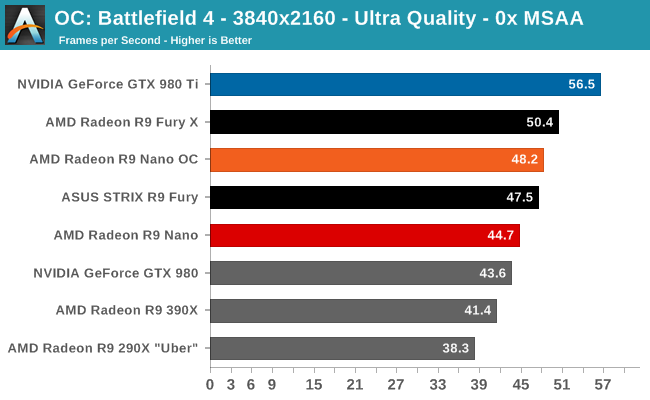

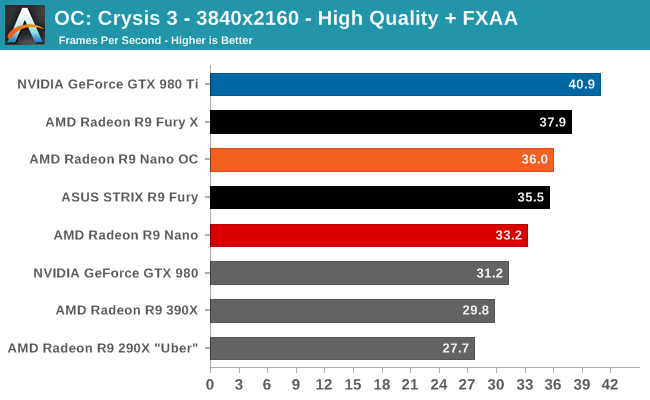
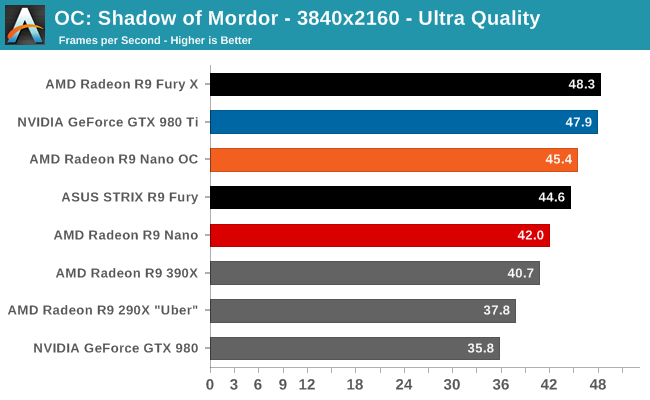
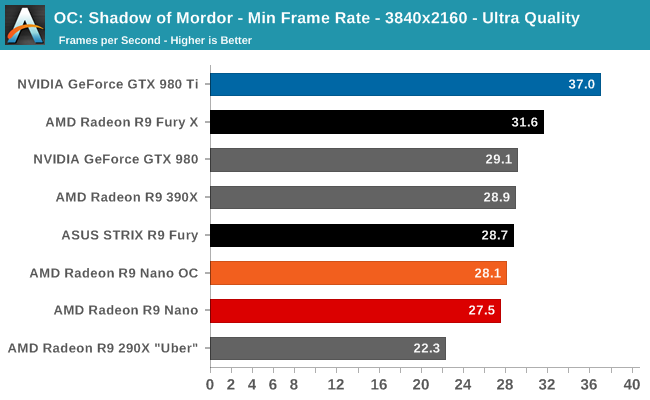
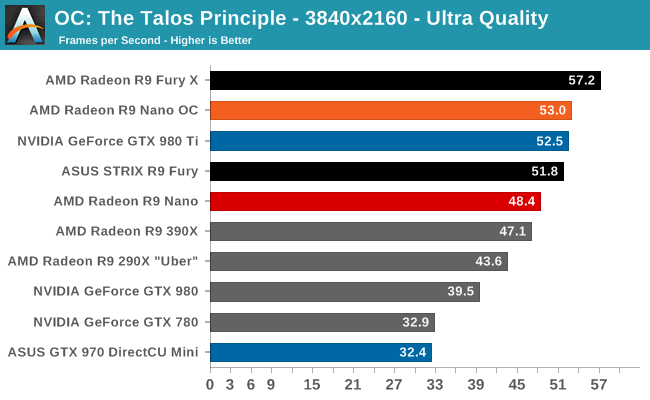
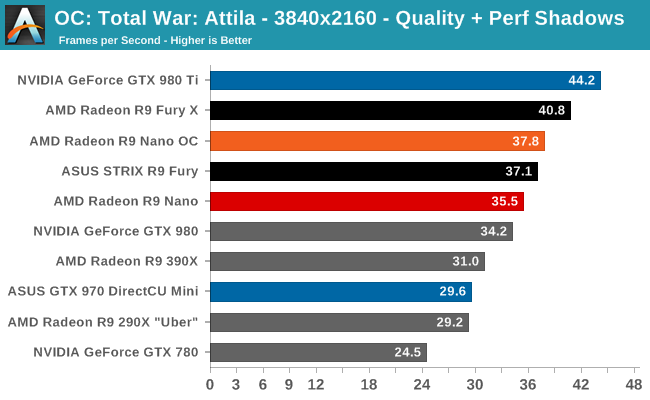
The overall performance gains from overclocking aren’t huge, but at 7-10% they also aren’t too shabby. However since higher clockspeeds quickly ramp up the power requirements due to the higher voltages required, the performance gains won’t be anywhere near the 35% increase in the power limit, despite that we are in fact still power limited.
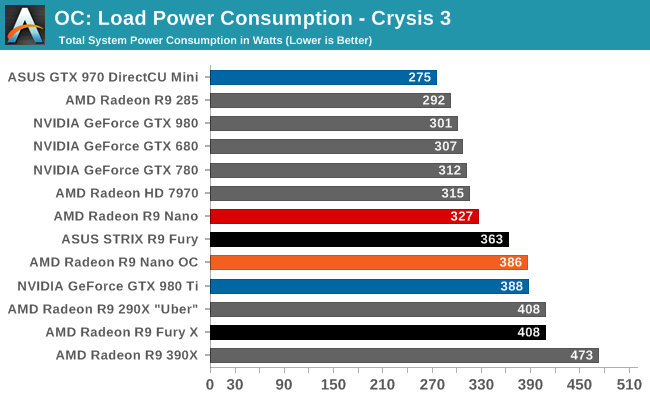
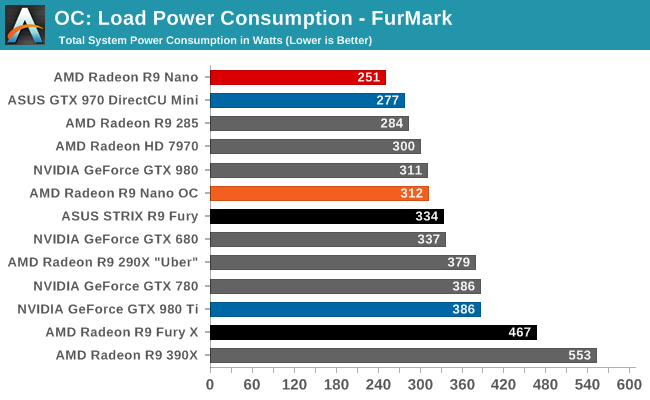
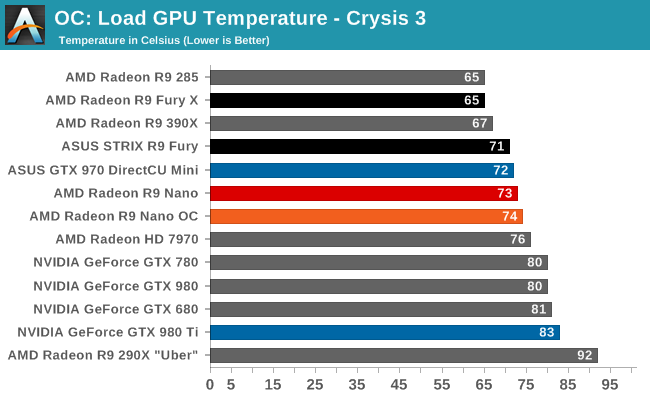
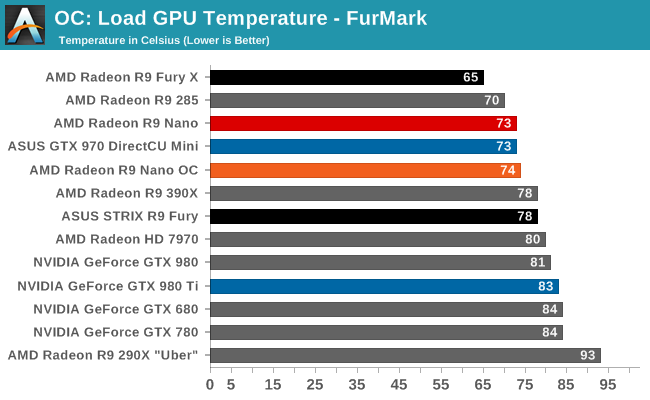
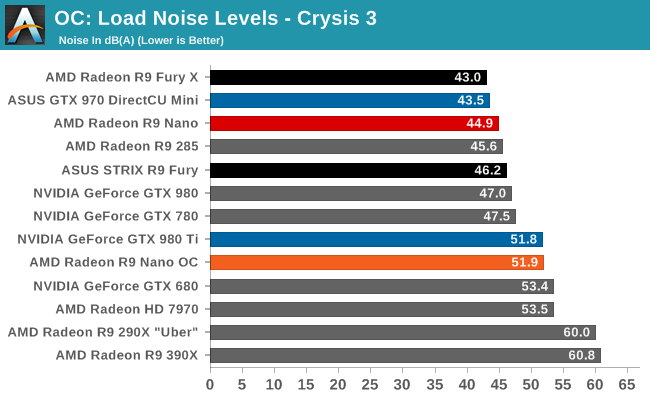
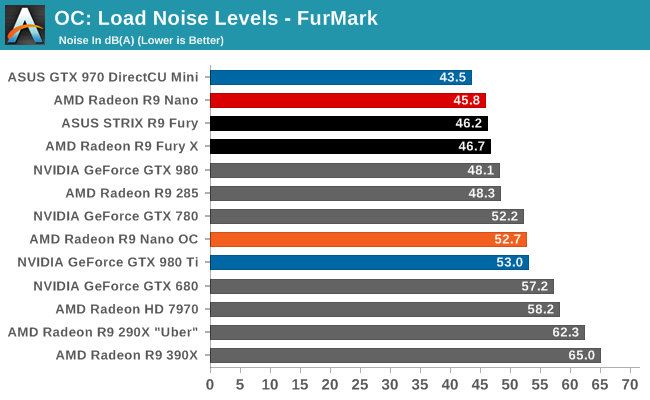
Meanwhile the 35% increase in the power limit has a definite knock-on effect on the cooling system. The R9 Nano’s cooler is able to keep up with the additional load, holding temperatures to 74C, but noise levels are now over 51dB(A). Power consumption at the wall is similarly affected, with the R9 Nano essentially giving up all of its energy efficiency gains in the process.










284 Comments
View All Comments
Drumsticks - Thursday, September 10, 2015 - link
??? I never said I was going to buy the Nano. You just said exactly what my plan was, to buy a GPU when 16nm FF hits. I'm still chugging along with 1080p and a 7850, but I'll probably be grabbing QuadHD or 4K next year with a big GPU upgrade.That doesn't mean that looking at potential DX12 performance now won't give a hint of what's to come, though. AMD stands to gain a lot from dx12 from what we've seen.
mosu - Thursday, September 10, 2015 - link
With a 16nm FinFet you'll get Nvidia, a 14nm FinFET will come from Glo-Foundries, so you'll get something from AMD.extide - Thursday, September 10, 2015 - link
It's NOT a lack of ROP's guys, its a lack of geometry bhardware. Check out the pixel fill rate tests, that does NOT indicate a lack of ROP's. This car beats the 980 at high res, but not low res, thats NOT a ROP issue, that's either driver overheard and/or geometry issue.silverblue - Friday, September 11, 2015 - link
I wonder if AMD has ever responded to the issue of driver overhead. If not, they should. It's a massacre at lower resolutions and detail levels at times.jardows2 - Thursday, September 10, 2015 - link
I do not see any enthusiast buying this card for their own build. Where I do see this card selling is in boutique systems sold for a combination of style and performance. In a tiny system targeted for 1440 gaming, which I think should be the focus rather than 4k, this would do great!MrSpadge - Thursday, September 10, 2015 - link
That voltage-frequency curve looks horrible! From the average clocks speeds we know the card is mostly running between 800 and 900 MHz. Yet on that plot we see no power states defined between 0.93 V and 1.04 V. Yet that's where the card would need to operate between 750 and 850 MHz. Why is AMD limiting their power efficiency by providing too few power states? Or is it simply a matter of measuring the low voltages correctly?teiresias - Thursday, September 10, 2015 - link
What were the terms Anandtech agreed to with Roy Taylor in order to secure this Nano sample? I honestly can't take any review of this product seriously unless the editorials of each site come out with statements on what their agreements with AMD were concerning review content.Ryan Smith - Thursday, September 10, 2015 - link
"What were the terms Anandtech agreed to with Roy Taylor in order to secure this Nano sample?"For the record I didn't need to agree to any terms. Nor have I conversed with Roy in quite some time.
jtrdfw - Thursday, September 10, 2015 - link
Thats good.Wreckage - Thursday, September 10, 2015 - link
If they agreed to anything it would probably be covered under a "non disclosure agreement" so legally they would not be able to say anything. Such an agreement would come from AMD marketing, not from Roy directly. I assume there was some sort of reviewers guide they wanted people to follow. How strictly any site followed that guide or why certain sites were deemed "fair" by AMD will most likely remain speculation